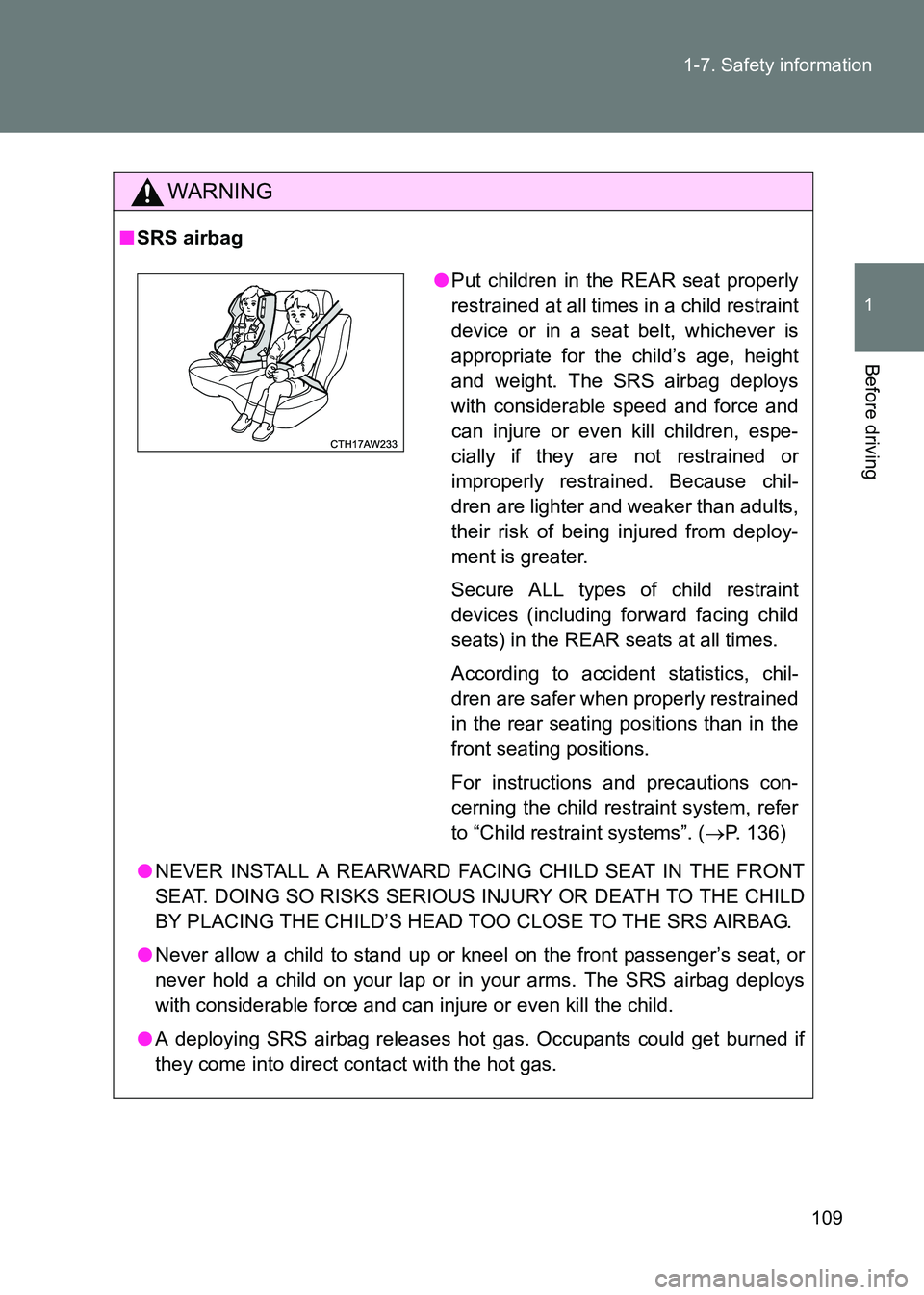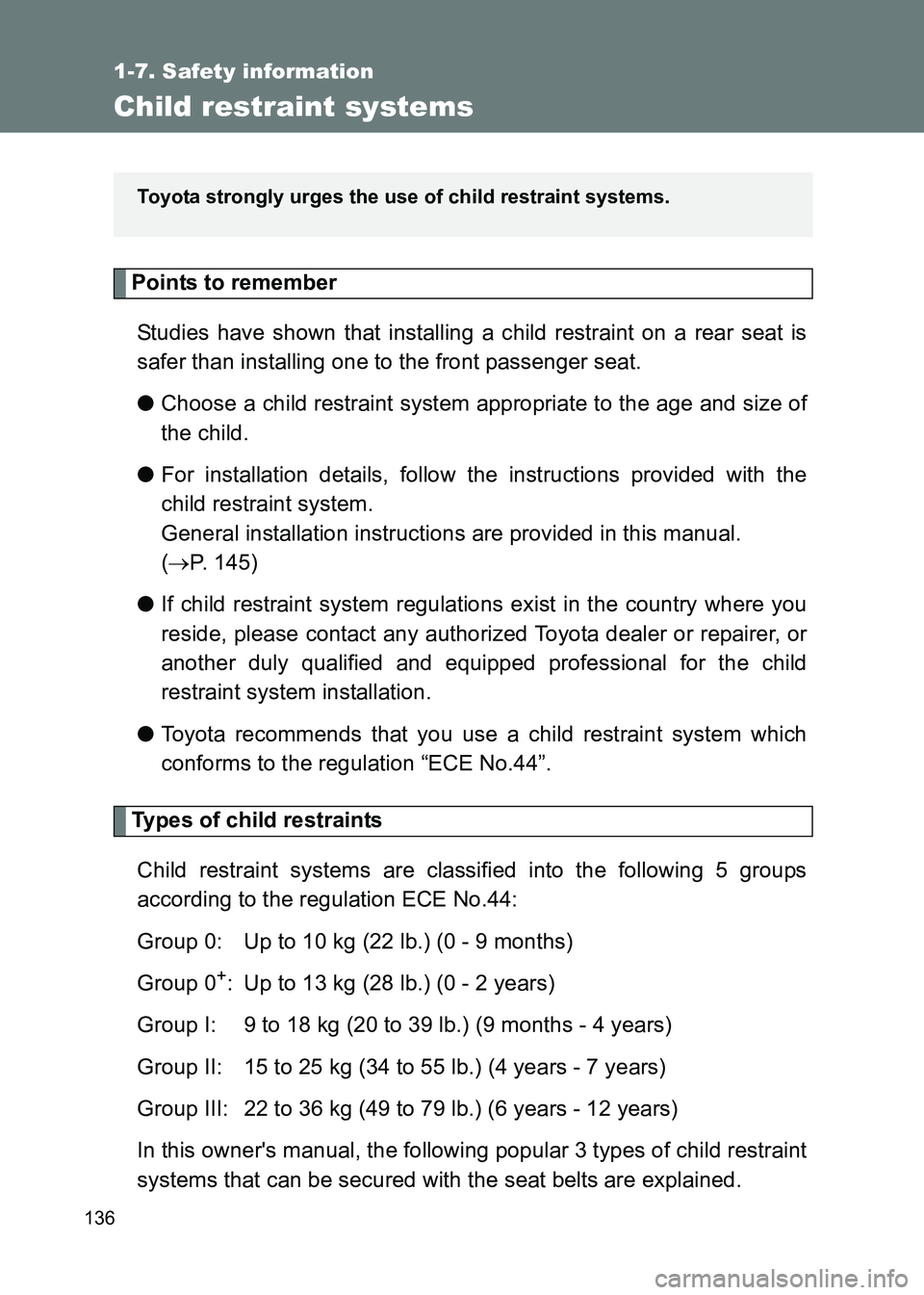Page 75 of 505

75
1-3. Adjustable components (seats, mirrors, steering wheel)
1
Before driving
86_EE (OM18071E)
■
Emergency locking retractor (ELR)
The retractor will lock the belt during a sudden stop or on impact. It may also
lock if you lean forward too quickly. A slow, easy motion will allow the belt to
extend so that you can move around fully.
■ Child seat belt usage
The seat belts of your vehicle are principally designed for persons of adult
size.
● Use a child restraint system appropriate for the child, until the child
becomes large enough to properly wear the vehicle's seat belt. ( →P. 136)
● When the child becomes large enough to properly wear the vehicle's seat
belt, follow the instructions on P. 73 regarding seat belt usage.
■ Seat belt pretensioners
●Seat belt pretensioners are not designed to activate in minor frontal or
side impact, in side or rear impacts or in roll-over accidents.
● The following four components operate simultaneously.
• Seat belt pretensioner for driver
• Seat belt pretensioner for front passenger
• SRS frontal airbag for driver
• SRS frontal airbag for front passenger
● Pretensioners are designed to function on a one-time-only basis. In the
event that a pretensioner is activated, both the driver’s and front passen-
ger’s seat belt retractor assemblies must be replaced only by any autho-
rized Toyota dealer or repairer, or another duly qualified and equipped
professional. When replacing seat belt retractor assemblies for the front
seating positions, use only genuine Toyota parts equipped with a force
limiter.
● If either front seat belt does not retract or cannot be pulled out due to a
malfunction or activation of the pretensioner, contact any authorized
Toyota dealer or repairer, or another duly qualified and equipped profes-
sional as soon as possible.
● If the front seat belt retractor assembly or surrounding area has been
damaged, contact any authorized Toyota dealer or repairer, or another
duly qualified and equipped professional as soon as possible.
Page 76 of 505

76
1-3. Adjustable components (seats, mirrors, steering wheel)
86_EE (OM18071E)
●
When you sell your vehicle, we urge you to explain to the buyer that it
has seat belt pretensioners by alerting the buyer to the contents of this
section.
■ Replacing the belt after the pretensioner has been activated
If the vehicle is involved in multiple collisions, the pretensioner will activate
for the first collision, but will not activate for the second or subsequent colli-
sions.
■ Seat belt regulations
If seat belt regulations exist in the country where you reside, please contact
any authorized Toyota dealer or re pairer, or another duly qualified and
equipped professional, for seat belt replacement or installation.
WARNING
Observe the following precautions to reduce the risk of injury in the event of
sudden braking, sudden swerving or an accident.
Failure to do so may cause death or serious injury.
■ Wearing a seat belt
●Ensure that all passengers wear a seat belt.
● Always wear a seat belt properly.
● Each seat belt should be used by one person only. Do not use a seat belt
for more than one person at once, including children.
● Toyota recommends that children be seated in the rear seat and always
use a seat belt and/or an appropriate child restraint system.
● To achieve a proper seating position, do not recline the seat more than
necessary. The seat belt is most effective when the occupants are sitting
up straight and well back in the seats.
● Do not wear the shoulder belt under your arm.
● Always wear your seat belt low and snug across your hips.
Page 77 of 505

77
1-3. Adjustable components (seats, mirrors, steering wheel)
1
Before driving
86_EE (OM18071E)
WARNING
■
Pregnant women
■ People with a medical condition
Obtain medical advice and wear the seat belt in the proper way.
■ When children are in the vehicle
Do not allow children to play with the seat belt. If the seat belt becomes
twisted around a child’s neck, it may lead to choking or other serious injuries
that could result in death.
If this occurs and the buckle cannot be unfastened, scissors should be used
to cut the belt.
Obtain medical advice and wear the seat
belt in the proper way. ( →P. 73)
Women who are pregnant should position
the lap belt as low as possible over the
hips in the same manner as other occu-
pants. Extend the shoulder belt com-
pletely over the shoulder and position the
belt across the chest. Avoid belt contact
over the rounding of the abdominal area.
If the seat belt is not worn properly, not
only pregnant woman, but also the fetus
could suffer death or serious injury as a
result of sudden braking or a collision.
Page 109 of 505

109
1-7. Safety information
1
Before driving
86_EE (OM18071E)
WARNING
■
SRS airbag
●NEVER INSTALL A REARWARD FACING CHILD SEAT IN THE FRONT
SEAT. DOING SO RISKS SERIOUS INJURY OR DEATH TO THE CHILD
BY PLACING THE CHILD’S HEAD TOO CLOSE TO THE SRS AIRBAG.
● Never allow a child to stand up or kneel on the front passenger’s seat, or
never hold a child on your lap or in your arms. The SRS airbag deploys
with considerable force and can injure or even kill the child.
● A deploying SRS airbag releases hot gas. Occupants could get burned if
they come into direct contact with the hot gas.
● Put children in the REAR seat properly
restrained at all times in a child restraint
device or in a seat belt, whichever is
appropriate for the child’s age, height
and weight. The SRS airbag deploys
with considerable speed and force and
can injure or even kill children, espe-
cially if they are not restrained or
improperly restrained. Because chil-
dren are lighter and weaker than adults,
their risk of being injured from deploy-
ment is greater.
Secure ALL types of child restraint
devices (including forward facing child
seats) in the REAR seats at all times.
According to accident statistics, chil-
dren are safer when properly restrained
in the rear seating positions than in the
front seating positions.
For instructions and precautions con-
cerning the child restraint system, refer
to “Child restraint systems”. ( →P. 136)
Page 129 of 505

129
1-7. Safety information
1
Before driving
86_EE (OM18071E)
WARNING
■
SRS airbag precautions
●The SRS front passenger airbag also deploys with considerable force, and
can cause death or serious injury especially if the front passenger is very
close to the airbag. The front passenger seat should be as far from the air-
bag as possible with the seatback adjusted, so the front passenger sits
upright.
● Improperly seated and/or restrained infants and children can be killed or
seriously injured by a deploying airbag. An infant or child who is too small
to use a seat belt should be properly secured using a child restraint sys-
tem. Toyota strongly recommends that all infants and children be placed in
the rear seats of the vehicle and proper ly restrained. The rear seats are
safer for infants and children than the front passenger seat. ( →P. 136)
●Do not sit on the edge of the seat or
lean against the dashboard.
● Do not allow a child to stand in front of
the SRS front passenger airbag unit or
sit on the knees of a front passenger.
● Do not allow the front seat occupants to
hold items on their knees.
Page 136 of 505

136
1-7. Safety information
86_EE (OM18071E)
Child restraint systems
Points to rememberStudies have shown that installing a child restraint on a rear seat is
safer than installing one to the front passenger seat.
● Choose a child restraint system appropriate to the age and size of
the child.
● For installation details, follow the instructions provided with the
child restraint system.
General installation instructions are provided in this manual.
(→ P. 145)
● If child restraint system regulations exist in the country where you
reside, please contact any authorized Toyota dealer or repairer, or
another duly qualified and equipped professional for the child
restraint system installation.
● Toyota recommends that you use a child restraint system which
conforms to the regulation “ECE No.44”.
Types of child restraints
Child restraint systems are classified into the following 5 groups
according to the regulation ECE No.44:
Group 0: Up to 10 kg (22 lb.) (0 - 9 months)
Group 0
+: Up to 13 kg (28 lb.) (0 - 2 years)
Group I: 9 to 18 kg (20 to 39 lb.) (9 months - 4 years)
Group II: 15 to 25 kg (34 to 55 lb.) (4 years - 7 years)
Group III: 22 to 36 kg (49 to 79 lb.) (6 years - 12 years)
In this owner's manual, the following popular 3 types of child restraint
systems that can be secured with the seat belts are explained.
Toyota strongly urges the u se of child restraint systems.
Page 137 of 505
137
1-7. Safety information
1
Before driving
86_EE (OM18071E)
Baby seat
Equal to Group 0 and 0
+ of ECE
No.44
Child seat Equal to Group 0
+ and I of ECE
No.44
Junior seat Equal to Group II and III of ECE
No.44
Page 138 of 505
138
1-7. Safety information
86_EE (OM18071E)
Child restraint system suitability for various seating positions
Provided information in the table shows your child restraint system
suitability for various seating positions.
Front passenger seat
Rear seat
Airbag manual on-off
switch
ON
OFF
0 (up to 10 kg [22 lb.]) X
Never put L3, L4 X
0
+ (up to 13 kg [28 lb.]) X
Never put L3, L4 X
I (9 to 18 kg [20 to 39 lb.]) Rear-facing
X
Never put L1 U
Forward-
facing L1
II, III (15 to 36 kg [34 to 79 lb.]) L2, L5 L2, L5
U, L2
Mass groupsSeating position